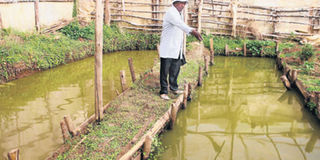With greenhouses, I beat the cold weather to keep fish

Onesmus Githui feeds fish in his farm in Nyeri. PHOTO | JOSEPH KANYI | NATION MEDIA GROUP
What you need to know:
- The retired Telecom Kenya employee ventured into fish farming in December 2010, three years after he had retired and injected in the business Sh20,000.
- The farmer has since expanded his business, and today, he is rearing over 35,000 fish in the ponds, excluding fingerlings.
- He farms tilapia and catfish, which he rears separately. However, he prefers tilapia because they multiply faster ensuring he has enough fingerlings and they have good market.
The weather is biting cold as we drive on a dusty road past Chaka market in Kieni to Catch Farm in Kairi village, Kabaru in Nyeri County.
The farm is located a kilometre-and-a-half from the Mt Kenya Forest, which offers a serene environment that supports farming ventures.
We arrive at the farm about 20 minutes later. Onesmus Githui, the owner, is clad in a white overcoat and a matching cap.
The farmer keeps fish on his half acre, which hosts 19 ponds in greenhouses.
“I rear the fish in greenhouses of various sizes, the smallest measuring 6 by 7m and the biggest 10 by 30m, because of the cold weather. Inside the greenhouses, my fish are able to multiply and grow faster enabling me to meet the growing demand,” offers Githui.
The retired Telecom Kenya employee ventured into fish farming in December 2010, three years after he had retired and injected in the business Sh20,000.
That time, his aim was to sell mature fish but he found the going tough since not many people then in the area ate the food. He diversified into fingerlings.
To start, he dug six ponds and bought a breeding stock of 200 male and female tilapia fish at Sh300 each.
“The ponds did not require dam liners because the area has clay soil which retains water. The fish bred after about two months enabling me to sell them and fingerlings to farmers and make Sh30,000 in my first harvest.”
The farmer has since expanded his business, and today, he is rearing over 35,000 fish in the ponds, excluding fingerlings.
He farms tilapia and catfish, which he rears separately. However, he prefers tilapia because they multiply faster ensuring he has enough fingerlings and they have good market.
According to Githui, catfish requires a lot of food and are not prolific breeders.
“To rear the fish, I also need to use pond liners for easy harvesting because when kept in earthen ponds, they hide under the mud making the harvesting difficult.”
He added that catfish further need artificial propagation to enhance their reproduction.
“I have to remove the pituitary gland from the male fish, grind and mix it with a hormone. I then take the mixture and inject into the female catfish and put it in a cage for a minimum of 12 hours.”
He then harvests the eggs by pressing the abdomen of the female fish from the pectoral fin towards the genital papilla and puts them in a container hosting semen extracted from the male fish.
“The mixing allows the semen to fertilise all the eggs. We then put the mixture in a temporary incubator made of polythene bag, a net, wood and water.”
The eggs later hatch and he stores them in a shallow pond ready for sale.
For tilapia, he does not need to go through the process. They are able to multiply on their own enabling him to have at least 2,000 fingerings for sale every month.
He feeds the fish on fishmeal, pollard, wheat or rice bran, canola waste, sunflower and cottonseed, which he mixes to make dough.
For the catfish, he occasionally feeds them with crushed meat because they are carnivorous. This prevents them from feeding on their young ones.
He feeds the fish twice a day, at 11am and 3pm.
“I also insert a sack of animal manure into the ponds after every two months to help in the growth of planktons, which make the best food for fish,” says the farmer who mainly sells fingerlings.
Sometimes he adds inorganic fertiliser; mostly DAP to increase fertility in the ponds.
Githui attracts customers from Laikipia, Nyeri, Kiambu and Nyandarua counties where he has been supplying fingerlings and fish. John Ngiri, a lecturer at the Department of Fisheries, Kenya Wildlife Service Training School in Naivasha, says in areas with low temperatures like those around Mt Kenya, greenhouse fish farming is recommended.
“The greenhouse helps to increase the temperatures and enhances faster growth of fish enabling them to attain the requisite weight for selling.”
He adds that organic manure especially that from chicken helps to enhance production of algae, which is good fish food and turns the water green, protecting the fish from predators.
Irvine Ong’amo from the Naivasha Fisheries Department says farmers practising artificial propagation of catfish can also keep the male and the female in the same cage after injecting the female with a hormone for production.
Githui sells the fingerlings at Sh15 each. He supplies between 2,000 and 3,000 a month.
He harvests the mature fish twice a month, after every seven months selling them at Sh300 each.





